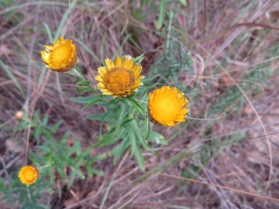 The more I am learning about the flora of HeatherTon, the more I realise how little I know, and how difficult it is to confidently identify some species. I am also finding that even the “experts” seem to disagree from time to time and that for us mere mortals this is often less of an exact science and more about opinions and hypotheses’! Having said that I am tending towards this week’s flower being identified as Helichrysum cooperi, but with some reservations that it may be H. molestum or H. difficile as H. cooperi is not found extensively in Mpumalanga. H. molestum means troublesome, burdensome, annoying, irksome and was so named by Olive Mary Hilliard, the renowned botanist and taxonomist because she was having so much trouble when she revised the Helichrysum genus.
The more I am learning about the flora of HeatherTon, the more I realise how little I know, and how difficult it is to confidently identify some species. I am also finding that even the “experts” seem to disagree from time to time and that for us mere mortals this is often less of an exact science and more about opinions and hypotheses’! Having said that I am tending towards this week’s flower being identified as Helichrysum cooperi, but with some reservations that it may be H. molestum or H. difficile as H. cooperi is not found extensively in Mpumalanga. H. molestum means troublesome, burdensome, annoying, irksome and was so named by Olive Mary Hilliard, the renowned botanist and taxonomist because she was having so much trouble when she revised the Helichrysum genus.
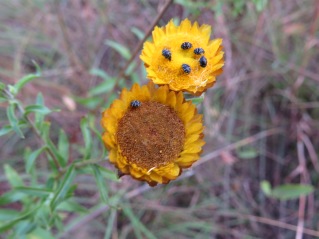 The genus name Helichrysum comes from the Greek words helios, meaning sun, and chrysos, meaning gold. Most species of this genus have golden yellow flowers. The Helichrysum genus has over 250 species in South Africa and over 500 species in Africa and are part of the very extensive Asteraceae (daisy) family. These herbs or shrubs may be annual or perennial and generally have woolly or felted leaves and stems. The flowerheads are often flat-topped and are borne in clusters on the tips of branches. These flowerheads are disc-shaped with several rows of chaffy or papery bracts that vary from white through straw-coloured to bright yellow. Some species may also have brown, pink, purple or red bracts.
The genus name Helichrysum comes from the Greek words helios, meaning sun, and chrysos, meaning gold. Most species of this genus have golden yellow flowers. The Helichrysum genus has over 250 species in South Africa and over 500 species in Africa and are part of the very extensive Asteraceae (daisy) family. These herbs or shrubs may be annual or perennial and generally have woolly or felted leaves and stems. The flowerheads are often flat-topped and are borne in clusters on the tips of branches. These flowerheads are disc-shaped with several rows of chaffy or papery bracts that vary from white through straw-coloured to bright yellow. Some species may also have brown, pink, purple or red bracts.
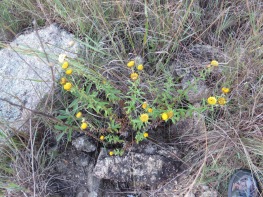 The Yellow Everlasting plants that I found are near a rocky outcrop, in the stony grassland that slopes south west down to our border stream. Unfortunately this stream has had little or no water over the summer and autumn and with very little hope of much more rain until September or October this year it will continue to be dry. The plants were between 400-1000 mm tall with alternate lanceolate leaves that clasp the stem. The leaves are green with fine hairs and entire margins. They have a prominent mid-rib and are aromatic when crushed. The stems are a lighter and covered with reddish hairs.
The Yellow Everlasting plants that I found are near a rocky outcrop, in the stony grassland that slopes south west down to our border stream. Unfortunately this stream has had little or no water over the summer and autumn and with very little hope of much more rain until September or October this year it will continue to be dry. The plants were between 400-1000 mm tall with alternate lanceolate leaves that clasp the stem. The leaves are green with fine hairs and entire margins. They have a prominent mid-rib and are aromatic when crushed. The stems are a lighter and covered with reddish hairs.
The flowerheads are 10-15mm in diameter and are surrounded by bright yellow bracts that fade to a straw colour as they mature. Each flowerhead may contain between 700-1130 florets. The flowers appear in late summer – March and April for all 3 species.
Below are 3 distribution maps for the species taken from http://keys.lucidcentral.org/keys/v3/helichrysum/key/Helichrysum/Media/Html/Helichrysum_cooperi.htm: et al
| Helichrysum cooperi | Helichrysum molestum | Helichrysum difficile |
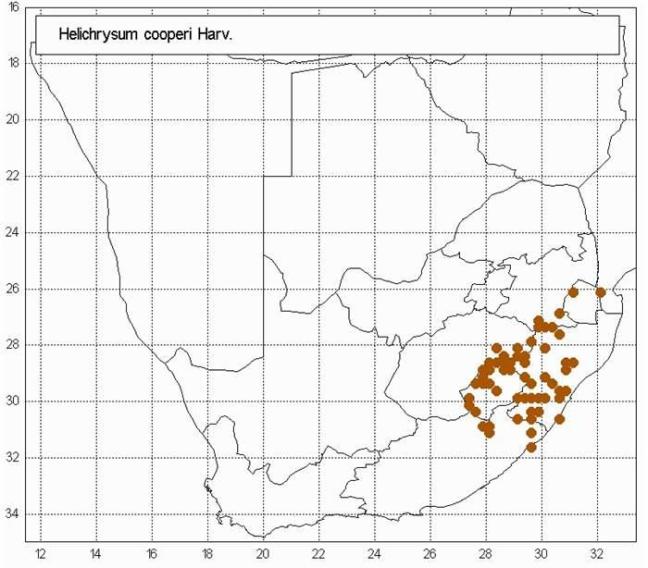 |
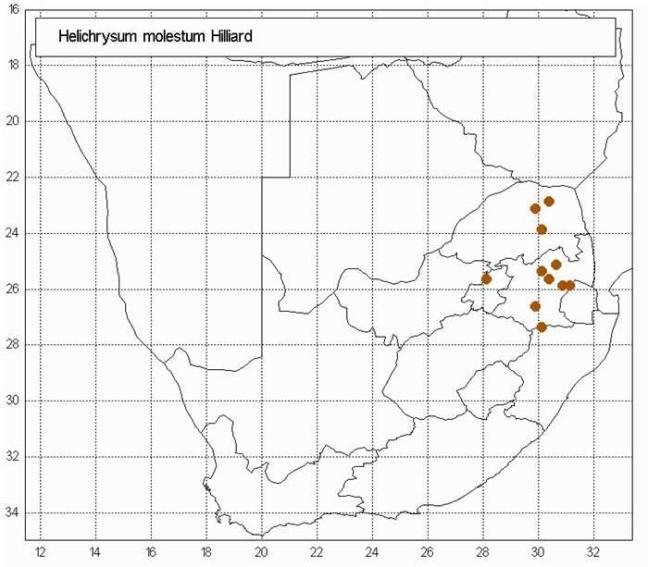 |
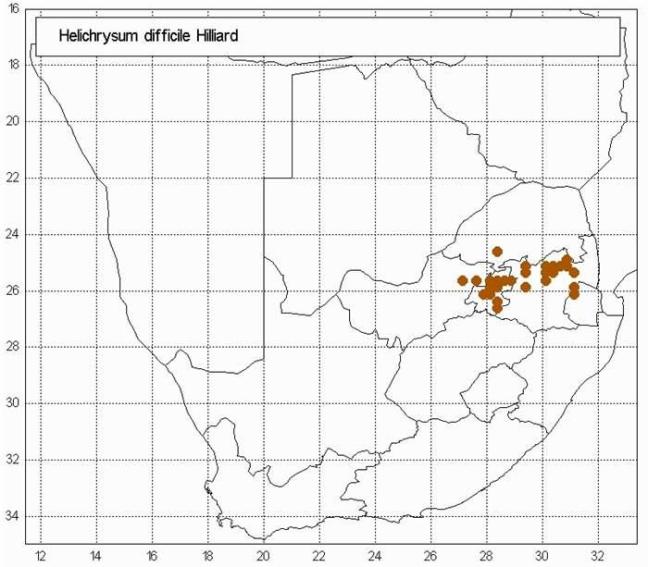 |
| Grows in grassland, often in the coarse herbage on or near forest margins, or, in the Drakensberg in particular, along drainage lines or in scrub among boulders and on scree. Recorded with certainty from the low Drakensberg on the Mpumalanga-KwaZulu-Natal border thence south through the mountainous parts of the Free State, Lesotho, and the Midlands and Uplands of KwaZulu-Natal to the Transkei and the Eastern Cape, between Maclear and Naude’s Nek | Favours moist ground in rough grassland or at the margins of scrub or forest patches. Recorded with certainty from the highlands of Mpumalanga, from Mount Anderson south to the Barberton mountains, but possibly ranges as far north as the Soutpansberg, west along the Magaliesberg, and south to northern KwaZulu-Natal. | Favours moist ground in rough grassland or at the margins of scrub or forest patches. Recorded with certainty from the highlands of Mpumalanga, from Mount Anderson south to the Barberton mountains, but possibly ranges as far north as the Soutpansberg, west along the Magaliesberg, and south to northern KwaZulu-Natal. |
A little whimsy – Chanter Pepperdancer
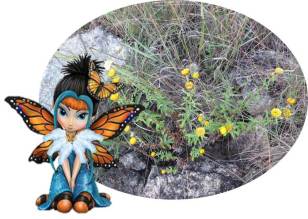 She plays tricks on small children and old folk. She lives in church yards and places of the dead. She can only be seen when the bees swarm and the crickets chirrup. She wears silver skirts and white feather down and has autumnal brown wings, like a butterfly.
She plays tricks on small children and old folk. She lives in church yards and places of the dead. She can only be seen when the bees swarm and the crickets chirrup. She wears silver skirts and white feather down and has autumnal brown wings, like a butterfly.







Very informative. Well written!
LikeLike